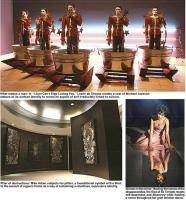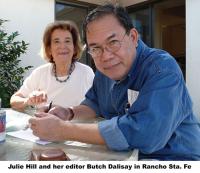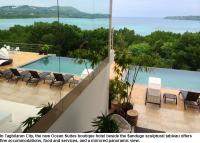I was in Cotabato City recently to attend a meeting of young Maguindanao leaders who planned to set up a political party in preparation for the autonomy that is being planned under the agreement with the Moro Islamic Liberation Front (MILF). It was the first time I visited Cotabato since the Fifties when I was all over the place. Cotabato was not divided then and was one of our largest provinces. In recent times, I have visited Davao, Cagayan de Oro, Jolo, and Zamboanga and noted how these cities have developed. I was surprised to see that Cotabato — yes, it had grown, too, but not in the scale of Davao or Cagayan de Oro. Again, the ancient question: Is it because Cotabato is almost totally Moro while Davao and Cagayan de Oro are not? This question was answered with what I first saw of Buluan, in Cotabato in the Fifties and yet again in the Sixties. Buluan, a Moro town, had remained almost unchanged while Marbel and Tacurong became prosperous. Is it because they were Christian? This is the facile and ready answer. It is incorrect though — the pioneering and immigrant spirit developed Tacurong and Marbel, the same spirit which enables the Moros to progress in non-Moro environment. Perspectives change with the geography. What we consider a normal reaction in Luzon takes a very sharp turn in Moro country and we immediately understand the need for looking at the age-old problems there in a different light from what Read More …

Dra. Thelma Navarrete-Clemente founded the Capitol Medical Center in 1970. It isn’t every day that one can wish someone a Happy 93rd Birthday, so I’m glad to exercise that privilege this week. On Saturday, Oct. 11, Dra. Thelma Navarrete-Clemente, one of the most accomplished ladies in our country, marks her natal day; the throwback doffs a cap to her birth at the Philippine General Hospital in 1921. Only fitting, too, as she went on to study, graduate from, and serve with distinction in that institution — which she still continues to support with her organizational skills, leadership, and philanthropy. “Thelma was the first of ten children born to Ursula (Frank) and her husband, Nicolas Navarrete of Panjulo (now Panghulo), Obando, Bulacan. At the time of her birth PGH was 11 years old, fairly new by building life-span standards, having opened its doors on Sept. 10, 1910. “… The newborn baby girl had not the slightest inkling then that 24 years later, she would do her parents proud by graduating from the UP College of Medicine, on her way to affixing that precious letter-suffix — MD — to her name.” Those paragraphs come from the first chapter of a coffee-table biography cum corporate milestones, titled Thely and Her Legacy: The CMC. The book will be launched at 2 p.m. on Wednesday, Oct. 8, at the Capitol Medical Center founded in 1970 by Thely, the nickname that stuck after the initial Thelmy. Illustrious guests are expected to attend this advance celebration of Read More …
Having written with dead seriousness about writing for six straight columns, I hope my readers will indulge me this digression — a periodic, practically biennial, one — having to do with utter frivolity. Okay, I’ll fess up: I have the new iPhone 6. Naturally. I’ve been an incorrigible Apple fanboy since the mid-1980s — practically since Apple was born — and so no one should be surprised by my prompt (I’ll say “timely”) acquisition of this new bauble, among 10 million other lunatics who snapped up the 6 and its bigger sibling, the 6+, in the gadget’s first three days of being on sale in the global market. Like an arthritic hippie or a superannuated rebel, I should have no business, as a card-carrying senior, salivating over shiny new toys better seen on 30-somethings dashing off to work or to a dinner date. Well, maybe a little. US demographic studies from 2012 suggest that nearly one-fourth of all iPhone users are 55 and older (and a bit lower for Android and BlackBerry users), so older guys (men use it more than women, 60-40 percent) still make up a good chunk of the iPhone market. That makes sense, because these things don’t come cheap. Along with literally millions of other people in the US and around the world, I stayed up until dawn on September 12 on the US East Coast to get my order in, and after an interminably long week during which I could only distract myself by doing Read More …

State of affairs: De Chavez symbolically uproots and turns over the Statue of Liberty, uncovering a shanty crammed with billboards, a statement on how our notion of freedom is coupled with capitalism. (Carlomar Arcangel Daoana is the inaugural winner of the Purita Kalaw-Ledesma Prize for Art Criticism in the 2014 Ateneo Art Awards. He has written catalogue and exhibition notes for various galleries, including Finale Art File, Avellana Art Gallery, Crucible Gallery, and Galleria Duemila. As a poet, he is the author of four collections, the most recent being Loose Tongue, a gathering of his uncollected poems written between 2001 to 2013, published by the UST Publishing House. In 2012, he won the grand prize in the Carlos Palanca Memorial Awards for Literature in the English Poetry category for his collection, The Elegant Ghost. Daoana will write a regular column for The STAR’s Art & Culture section. This is his winning piece.) In the video installation “Sisa,” the artist Ea Torrado translates the frantic, anguished search of the beleaguered Noli Me Tangere character through a series of sharp, uncoordinated movements, brutal spins, and resistance and submission to gravity. Rather than the names of her lost sons Crispin and Basilio, Sisa howls those of the desaparecidos, men and women who, because of their political leanings, were abducted during the Marcos regime, never to be seen again. It is this sense of loss that haunts and electrifies “Complicated,” which has just recently wrapped up at the Lopez Museum and Library in Pasig Read More …
To my pleasant surprise, last week’s piece on what editors do drew a stream of positive responses — I never imagined that so many readers would find the thankless and dimly illuminated job of editing so fascinating — but my biggest surprise after the column came out was to realize that I’d already written not just one but two columns on editing, back in 2010. Thankfully, I didn’t repeat myself too much, and since I’ve already written dozens of pieces on, say, fiction and nonfiction, I don’t see why I can’t do a fourth one on editing, focusing this time on how an editor thinks or should think. But before I go one step further into the trenches, let me just point out another important fact about the editor’s job. Particularly in a journalistic context, where some element of public interest is presumably involved (as opposed to literary publishing, which comes down to very personal tastes), “editing” involves much more than dotting i’s or finding better substitutes for problem words. Editing in journalism inevitably involves matters of policy — the publication’s policy in respect of the treatment of, say, political and social issues. What newspaper and magazine editors worry or should worry about are spelled out in a textbook titled Creative Editing by Bowles and Border (Wadsworth, 2000), which says, in a chapter on Situational Ethics: “Copy editors are likely to be concerned with decisions involving the writing, editing and production processes: Is the use of profane language or obscene Read More …
One, the term sounds like testicles. Which can only recall for us, quite sordidly, that chapter in Philippine impeachment history when a lawyer kept pirouetting with his perorations on the tes-TI-mony of a Madame Wetness. Two, the number involved keeps getting arbitrary. From good old 10 (… Spectacular Philippine Beaches You’d Best Bring 20 Bitches To) to the equally solid if expanded 30 (… Ways to Leave Your Lover), now the number can be anywhere between single-digit (except for 2 or 3 or 4) to double digits, prime or not. Which leads us to the next reason… Three, whichever number you use, it will always take you to ye olde association game. The prime 5 is dynamic and a basketball team’s first contingent oncourt. When the La Salle Green Archers play the Ateneo Blue Eagles, they’ll always be at “sixes and sevens” with us; the 6 of course also reminding us of the Star of David, which has one point more than our trad parol, while 7 isn’t just luck with the dice but also partners and rhymes with heaven. Eight suggests infinity, thus the number requested by wealthy Chinese for repetition on their car plates, 9 is the number of lives of that arrogant animal that we now find to have been misrepresented by a false icon we’ve been greeting Hello Kitty. Ten is the usual cardinal demarcation for a top-something list. Eleven is another prime number, usually partnered with fellow-prime and rhyming, dice-y 7. Twelve would be the Read More …
Liv Vinluan, Paulo Vinluan and Nicole Sy Coson hold simultaneous shows, which are on view until Aug. 30 at Finale Art File, Warehouse 17, La Fuerza, 2241 Chino Roces Ave., Makati City. At the Tall Gallery, Liv depicts the boat as a compelling symbol of loss, change and survival in “The Savage Sea.” At the Video Room, Paulo creates complex configurations using three main forms — the human figure, the sphere and the cube — and in the process unpacks a repertoire of references and stories related to them in “Block: New Paintings.” At the Upstairs Gallery, Nicole presents small monotype prints with forms that straddle the line between abstraction and reality. For details, call 813-2310, email finaleartfileinc@gmail.com or visit www.finaleartfile.com. View all Lifestyle Feature ( Article MRec ), pagematch: 1, sectionmatch: * * * Benjie Cabrera at The Crucible Benjie Cabrera attempts to capture the moment of creation at what is “now and here” in “Maze of Thought,” which opens tomorrow at The Crucible Gallery, SM Megamall A, Mandaluyong City. The show runs until Sept. 7, For information, call 635-6061. * * * Pio Abad at Vargas Museum Pio Abad employs strategies of appropriation to reveal the social and political significations of objects, unraveling the circumstances in which artworks and commodities are made, presented and exchanged in “The Collection of Ryan & William Saunders,” which opens on Aug. 28 at the Ground Floor Lobby & West Wing Galleries of Jorge B. Vargas Museum, QC. The show runs until Sept. 30. Read More …

In my other role as an editor rather than a writer of books, I take raw manuscripts from clients and friends and transform them into something publishable and popularly readable. I’ll write more about editing as a profession one of these days, because it’s an art unto itself that bears all the challenges but very little of the glamor and rewards of authorship. In the meanwhile, I’d like to talk about one of my most recent editing projects, a book about travels around the world by someone who has to be the most happily peripatetic (that’s a fancy word for “footloose”) person I know. Julie Hill was a client before she became a friend. We were introduced to each other more than 10 years ago by Jimmy Laya, who knew Julie and her late husband Arthur back from when the Hills lived in the Philippines, where Arthur represented the Ford Foundation. Then based in Southern California, Julie wanted to write a book about her life and travels with Arthur, who had just died of cancer; together, the couple had journeyed around the world, from Australia to Afghanistan, from Bangkok to Minnesota, from Samoa to China. Julie — born an Alexandrian Greek, trained in chemistry, and later a telecommunications executive — had all these stories to tell, and she needed an editor to help her tell them. Jimmy put us together, and Julie’s first book, Promises to Keep: The Travels of Arthur and Julie Hill, came out in 2003, published by Read More …

The Blue Fairy (played by Liesl Batucan) visits Pinocchio (Noel Comia) in Rep’s Theater for Young Audiences’ production of Pinocchio, which opens on Aug. 16 at 10:30 a.m. at Onstage Theater in Greenbelt One. PHOTOS BY JOJIT LORENZO One of my favorite quotes comes from an article on theater for children by Lauren Gunderson who, quoting Bill English of San Francisco’s SF Playhouse, wrote, “Theater is like a gym for empathy. It’s where we can go to build up the muscles of compassion, to practice listening and understanding and engaging with people that are not just like ourselves. We practice sitting down, paying attention and learning from other people’s actions. We practice caring.” This is what I love about theater. Learning comes so easily, affects deeply, and lasts a lifetime. To my mind, nothing gives such a clear understanding of human nature as theater does —“understanding and engaging with people that are not just like ourselves.” And this is why I am passionate about theater for children. They need to learn to care. We care for our children’s health. We see that they get their shots, their vitamins, their check-ups, that they get enough sunshine and exercise and that they eat the right food. We try to give them the best schooling possible. But sometimes we overlook how vulnerable and sensitive children’s minds are and that there is another part of their brain that needs care and feeding, too. Our children are made to grow up too fast. Electronic devices, Read More …

Eskaya Beach Resort & Spa’s Presidential Villa offers top-of-the-line luxury plus a viewdeck with an infinity pool merging with the Bohol Sea. Ahh, R&Rs. While I accept and love being MetroManileño through and through, from cradle to likely grave, like most of you of course my long tooth gnashes itself, all by itself, whenever confronted with insufferable traffic. Especially when this is largely caused by the left hand of government challenging the right hand to a wrestling match. As has been the case of late, given the eyeball contest between the MMDA and LTFRB. Oh, that last agency happens to also fall under the DOTC, yes. So what’s with the DOTC, when most of the complaints that have mounted against government service appear to involve this humongous, powerful agency — which seems to be ever mired in a bog of analysis-paralysis? Our terrible airport terminals. The MRT. The LRT-MRT connection desideratum. The continuing deficiency with regard LTO’s issuance of vehicle plates sans that extra process of meting out conduction stickers — which are of course produced for a fee. And the LTO/DOTC heads have the gall to say they’ll soon issue a “No Plate No Travel” edict, because they say the prob is that vehicle owners and distributors don’t get the plates when so many are ready already? And now the LTFRB releases 8,000 colorum vehicles on our congested avenues and streets? Jeez, it’s when I wish all the anti-PNoy voices would start to also choose the battles we really Read More …